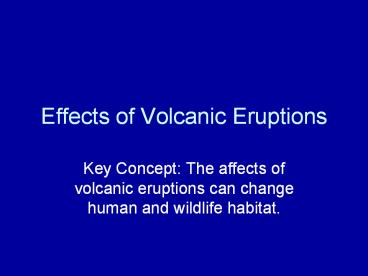Effects of Volcanic Eruptions - PowerPoint PPT Presentation
1 / 18
Title:
Effects of Volcanic Eruptions
Description:
Effects of Volcanic Eruptions Key Concept: The affects of volcanic eruptions can change human and wildlife habitat. Negative Effects of Volcanic Eruptions Volcanic ... – PowerPoint PPT presentation
Number of Views:183
Avg rating:3.0/5.0
Title: Effects of Volcanic Eruptions
1
Effects of Volcanic Eruptions
- Key Concept The affects of volcanic eruptions
can change human and wildlife habitat.
2
Negative Effects of Volcanic Eruptions
- Volcanic explosions can have local and global
effects. - In April 1815, Tambora volcano in Indonesia
erupted explosively. - The pyroclastic flows and falling debris killed
about 10,000 people in the area.
Crater
3
- High in the atmosphere, ash and gas spread around
Earth. - The average global temperature decreased by as
much as 3C for one to two years. - The lower temperature caused crop failures and
starvation, particularly in New England and
Europe.
4
- The effects of lower temperatures led to the
deaths of about 82,000 people. - Therefore, an estimated total of 92,000 people
around the world lost their lives as a result of
the Tambora eruption.
5
Local Affects of Volcanic Eruptions
- Volcanic eruptions can cause loss of human life
and loss of wildlife habitat. - The blast from an explosive eruption can knock
down trees, destroy buildings, and kill humans
and animals.
6
- Pyroclastic flows can burn everything in their
path. - Hot volcanic materials can melt the snowcap on a
mountain, causing devastating floods.
7
- Volcanic ash can mix with water to form
fast-moving mudflows called lahars. - The weight of falling ash can collapse
structures, bury crops, and damage engines. - Volcanic ash can also cause respiratory problems
in humans.
8
Global Effects of Volcanic Eruptions
- Large volcanic eruptions can affect Earths
climate for several years. - During large eruptions, ash and sulfur-rich gases
can be pushed into the stratosphere. - As the ash and gases spread around the planet,
they absorb and scatter sunlight.
9
- Enough sunlight may be absorbed or scattered to
lower the average global temperature of Earth. - In 1991, after the eruption of Mount Pinatubo in
the Philippines, the amount of sunlight to reach
Earths surface decreased by 2-4. - This decrease caused the average global
temperature of Earth to decrease by several
tenths of a degree for several years.
10
Benefits of Volcanic Eruptions
- Volcanic soils are some of the most fertile soils
on Earth. - Volcanic rocks are made of minerals that contain
elements important to plant growth. - When volcanic rocks break down, they form soils
that contain many nutrients that plants can use.
11
Geothermal Energy
- Magma heats the rocks that surround it.
- These rocks often hold water that also becomes
heated. - This heated water, called geothermal water, may
reach temperatures of hundreds of degrees
Celcius.
12
- Geothermal water contains large amounts of heat
energy. - This energy can be tapped by drilling wells to
reach the hot water. - Water can also be pumped through heated rocks to
obtain energy.
13
- Geothermal water can be used to drive turbines
that generate electricity. - It can also be used to heat homes, grow crops, or
keep roads free of ice.
14
- Volcanic rocks are often used in construction.
- As early as 300 BCE, Romans made concrete from
volcanic ash and lime. - This material was used to build the Colosseum in
Rome in 80 CE. The strength of this material has
allowed the Colosseum to stand for nearly two
thousand years.
15
- As recently as the 20th century, volcanic ash was
used to make concrete for dams in the United
States. - Today, basalt and pumice are often used in the
construction of roads and bridges, and the
production of concrete.
16
- Pumice is added to soil to allow air and water to
circulate more easily through the soil. - Because metals in pumice are not water soluble,
pumice is used alone or with silica sand to
filter drinking water.
17
- Use these term to fill in concept map.
- eruptions
- shield volcanoes
- cinder cone volcanoes
- composite volcanoes
- lava
18
(No Transcript)































